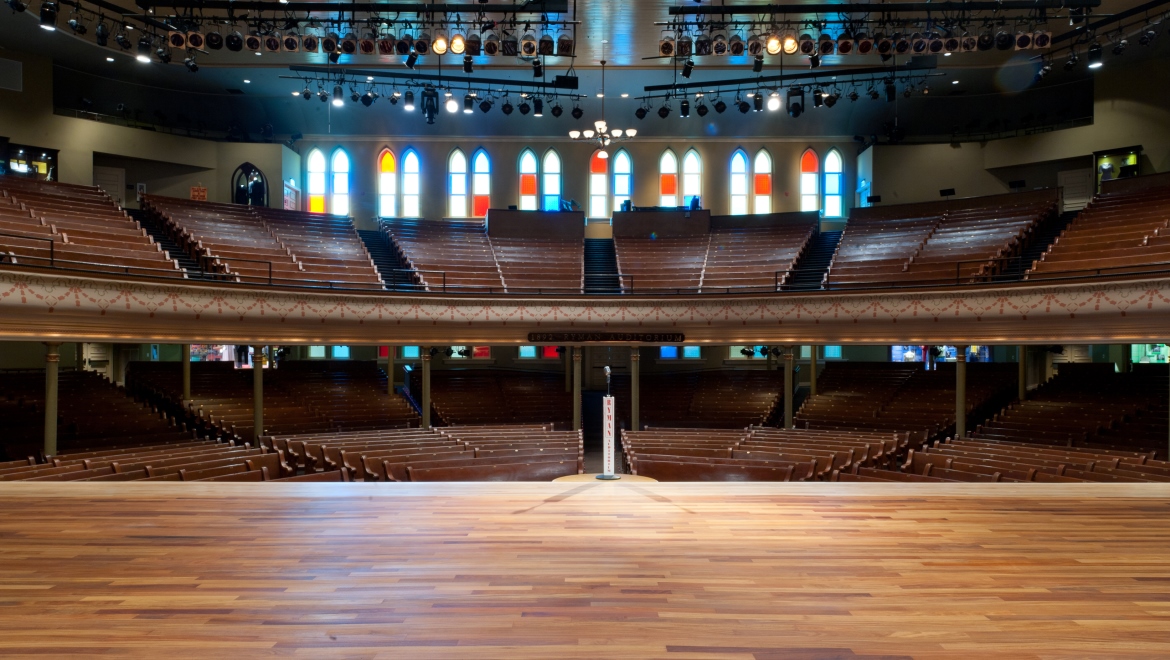Ryman Auditorium Information

The story of the Ryman Auditorium begins in 1885 with a tent revival led by evangelist Sam Jones. This revival was attended by 5,000 people including Thomas G. Ryman, a famed steamboat captain, and Nashville businessman. Ryman was moved by the experience and dedicated himself and his fortune to building the Union Gospel Tabernacle, where everyone could gather and worship. The Tabernacle took seven years to complete and cost $100,000 which is equivalent to nearly $3 million in 2018.
Sam Jones, inspired by Ryman’s work and generosity, held his first revival at the site two years before it was completed. Jones had wanted to name the building in Ryman’s honor, but Ryman refused multiple times preferring to keep the Union Gospel name. When Ryman passed away in 1904, his memorial was held at the tabernacle and Sam Jones proposed that the building be renamed Ryman Auditorium, a proposal that was met with eager approval by attendees.
Even though Ryman Auditorium was originally designed as a house of worship, it was often leased to promoters for secular events to help pay off the $20,000 debt that was accrued because construction exceeded the budget. This includes many events that were booked by Lula C. Naff in 1904 which included engagements, concerts, boxing matches, and other similar attractions. Naff would go on and make booking her full-time job when her former employer went out of business. She became Ryman Auditorium’s official manager in 1920 and preferred to go by the name of L.C. Naff to avoid prejudice against female executives.
Naff gained a powerful reputation for battling against censorship groups that attacked various performances and performers that many considered too risqué. This led to an incredible win when Naff won a lawsuit against the Nashville Board of Censors, who had planned to arrest the star of the play Tobacco Road due to its nature, with the court declaring the law creating the censors to be invalid. Naff’s championship of free speech in performance art and her ability to book world-renowned entertainers kept the Ryman as the place to go in Nashville and enhanced the city’s reputation as a center for the performing arts. Her work helped the venue earn the nickname “The Carnegie Hall of the South”, and the distinction of hosting lectures by Presidents Theodore Roosevelt and William Howard Taft in 1907 and 1911 respectively.
Naff also helped to set an early precedent for the Ryman supporting diversity, when it hosted its first sold-out event in 1913 with a lecture by Helen Keller and Anne Sullivan Macy. Naff was a trailblazer for women, but she also used the Ryman as a regular venue for black performers including the Fisk Jubilee Singers from Fisk University. While Jim Crow laws forced Ryman audiences to be segregated or to have events designated for “white audiences only” or “colored audiences only”, photographs showed that there were many times when the audience was integrated. Naff retired in 1955 and passed away in 1960.
During Naff’s time with the Ryman, the Grand Ole Opry became a Nashville institution, broadcasting to over 30 states in the eastern United States. The Opry was attracting listeners and audience members across the region and had to move to different studios in the 30s to accommodate a growing audience pool to include War Memorial Auditorium in 1939. But when reports came in of repeated upholstery damage from rowdy crowds, the Opry was asked to leave War Memorial and find a new home. Naff and other Ryman leaders offered the auditorium for The Opry. The Opry accepted and made their first broadcast from the Ryman on June 5, 1943, and remained there for nearly 31 years with sold-out shows every time, with hundreds of fans having to be turned away.
The Opry was a turning point for the Ryman, as they often hosted the biggest country music stars. This reputation and the frequently sold-out shows melded the original usage of The Ryman as a house of worship, with its popular usage as a country music venue earning it the nickname “The Mother Church of Country Music”, which holds to this day. But this growth had early troubles, as the venue was not designed to be a performance venue, so it lacked a backstage and had only one men’s dressing room, with women having to use the ladies restroom. Performers often had to wait in the wings, narrow hallways, or the alley behind the building’s south wall.
The Opry’s relationship with Ryman Auditorium continued, even after WSM, Inc. purchased the building in 1963 and renamed it The Grand Ole Opry House, though fans kept using the Ryman name. The Ryman Auditorium later officially regained its name after The Opry moved to its theme park in the early 1970s.
The Ryman faced trouble at this point, as WSM announced plans to demolish the Ryman to build a new chapel. This was partially spurred on by shareholders feeling that the Ryman was insufficient for enjoying musical performances, with Roy Acuff even saying “I never want another note of music played in that building.” He and others with similar views felt that the dressing room situation was bad enough to warrant reconstruction or replacement. But members of historic preservation groups argued that the Ryman had too much religious history and argued against them. The initiative raised an outcry that eventually led to WSM tabling the decision of the Ryman’s fate and saving it from demolition.
The auditorium was quiet for 20 years following this decision. It was only used for tours and as a historic tourism spot while the area around it fell to urban decay. It seemed like the Ryman would fall into history as a high point of musical and religious history. It faced near destruction to car bombs intended for nearby businesses, decay from disrepair, and an uncertain future from a lack of performances and events.
Things turned around for the Ryman after it was acquired by Gaylord Entertainment, which was later renamed Ryman Hospitality Properties, in 1983. Ever since then, the Ryman has hosted several events including the filming of several movies including John Carpenter’s Elvis and Clint Eastwood’s Honkytonk Man. The building would see several renovations over the years that improved its appearance, added essential features such as an updated stage, that would lead it to become one of the most venerable venues in Nashville, with acoustics that many experts claim is one of the best in the world. It helped revitalize Nashville’s downtown district into a place for locals and tourists and has hosted memorial services for many country music stars and legends.
The Ryman celebrated its 125th-anniversary celebration in 2017, where it also welcomed Little Big Town as its first artist-in-residence who performed 10 shows over the year.
To this day, the Ryman stands tall as one of Nashville’s most important historic locations. From its humble origins as a place of worship to its current place as the heart of country music and a champion of diversity and performance art, fans can expect a memorable and timeless experience with any show they get to see.
For further information on Ryman Auditorium please read the following pages:
Ryman Auditorium Parking:
Read all available parking options at the Ryman Auditorium.
Ticket Policies:
Find out more about our ticket guarantee and other ticket policies.
Ryman Auditorium Seating Chart:
View the main seating configuration for the Ryman Auditorium events and find out more about accessible seating.
Ryman Auditorium Tours:
Ryman Auditorium is famous for tours around the venue. If you are interested, read this page for more information.
